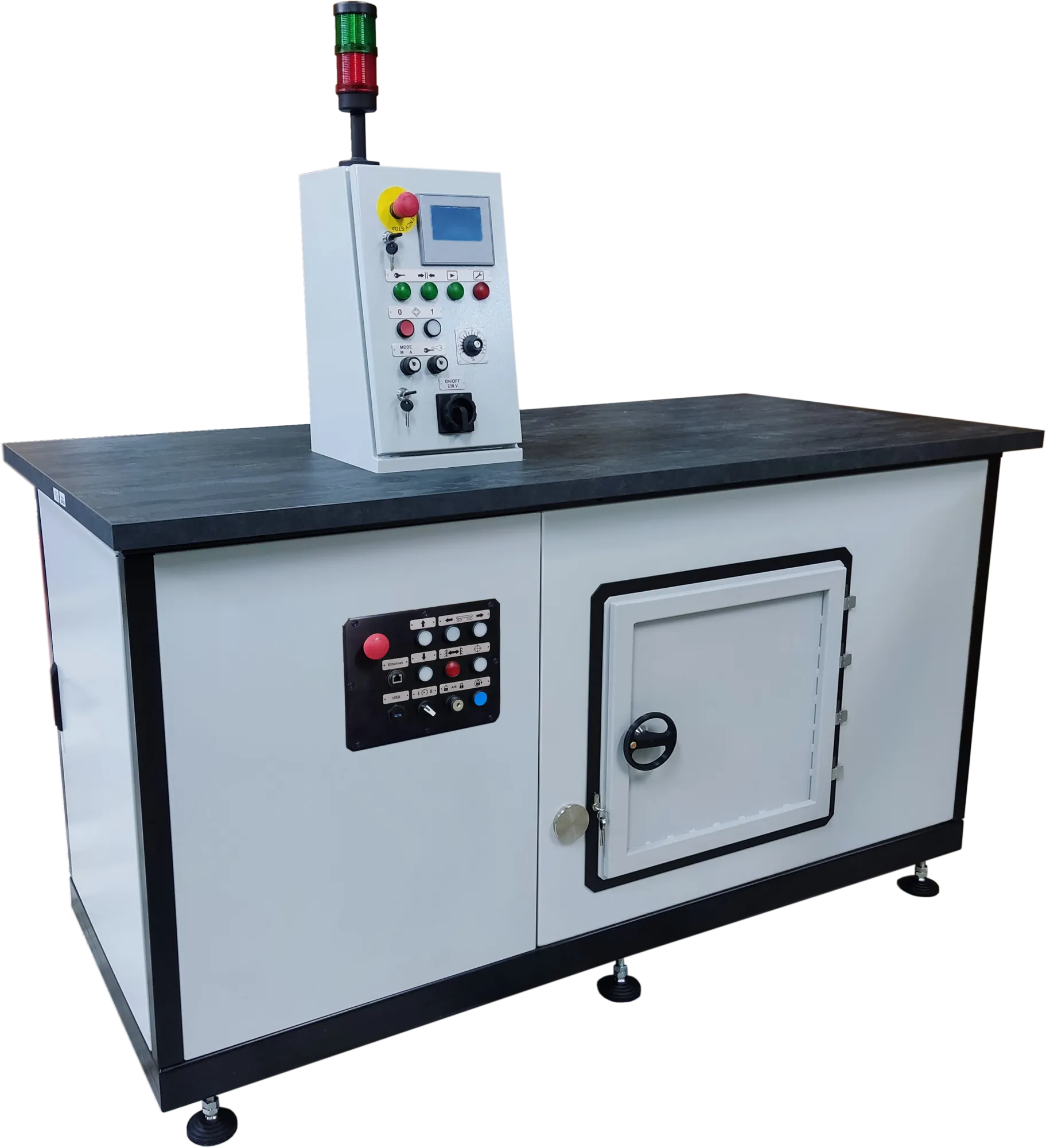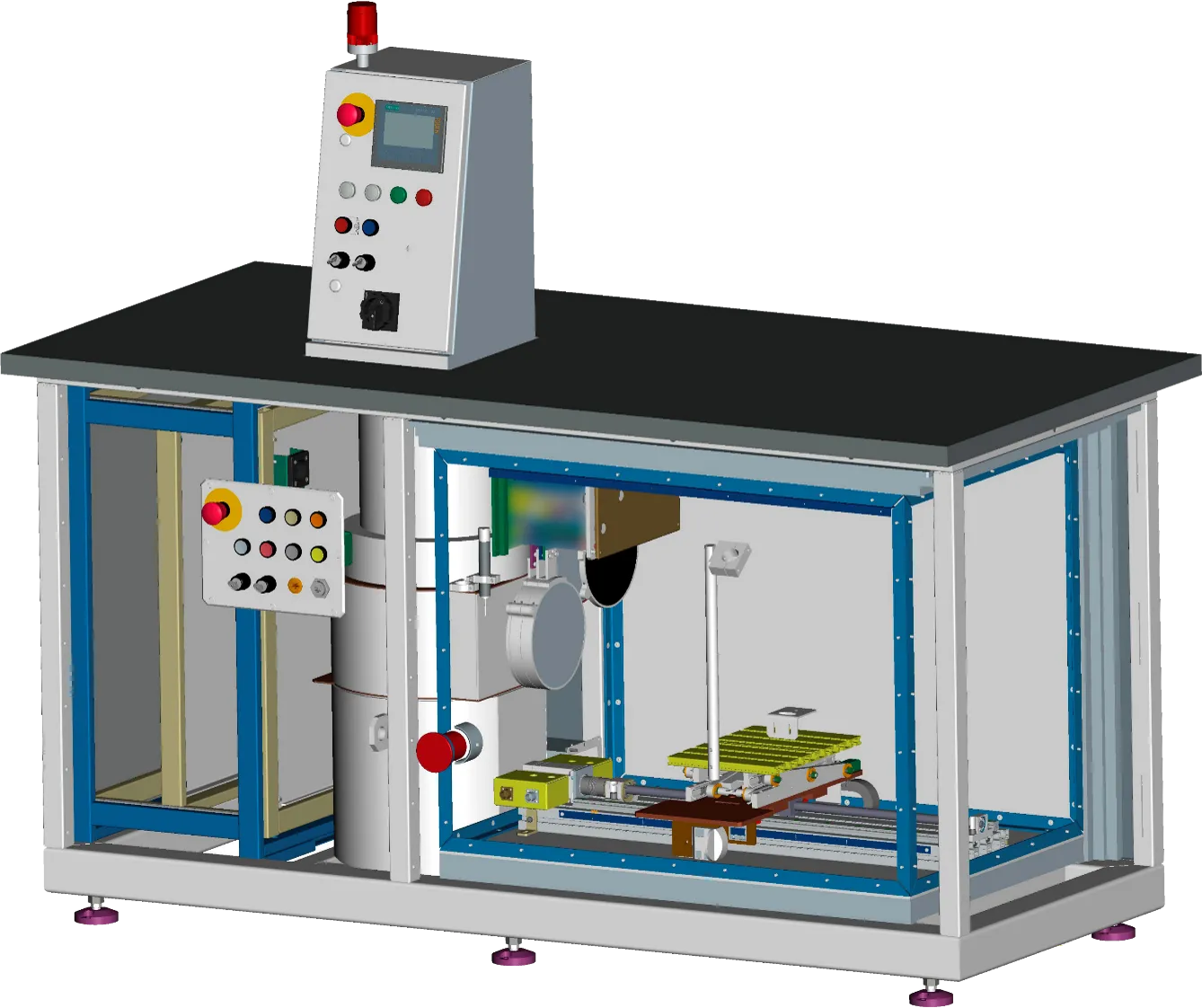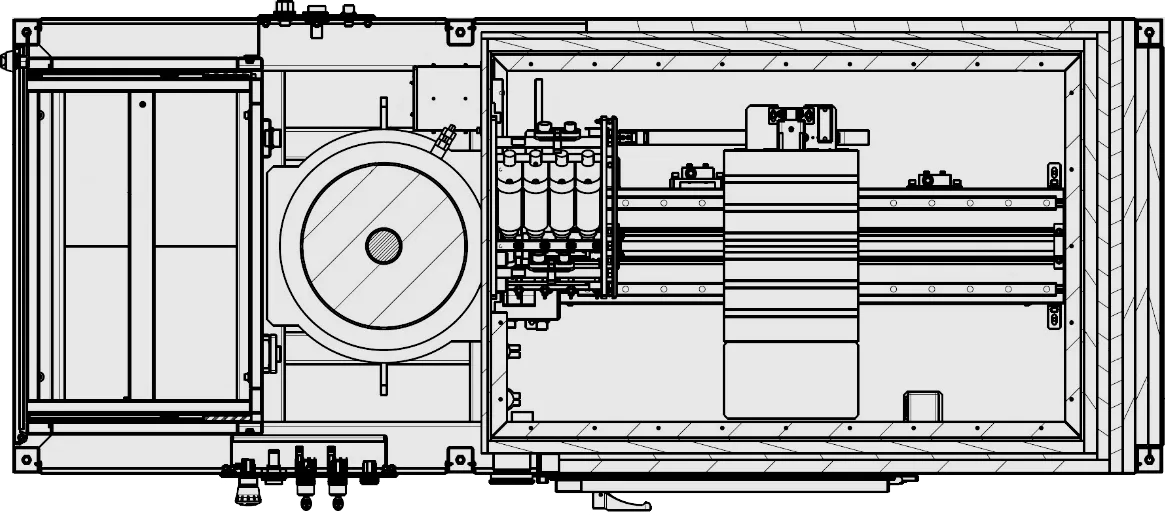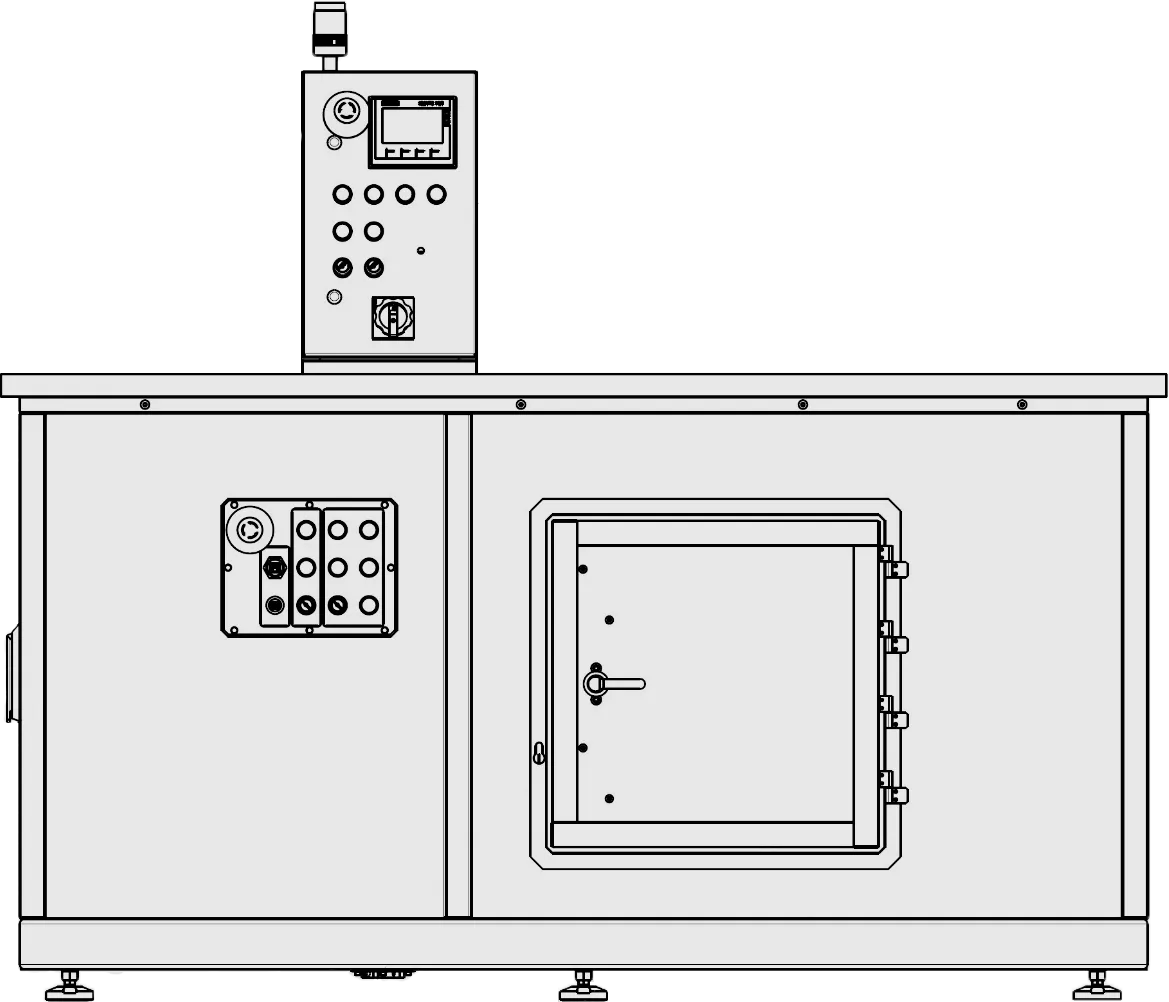Self-Contained Gamma Irradiator PM9300
New
Safe and compact self-contained irradiation calibration system that doesn`t require special room. Designed for verification, calibration, and quality assurance of the radiation instruments that measure exposure dose and exposure dose rate, air kerma and kerma rate, dose equivalent and dose equivalent rate, personal dose equivalent and personal dose equivalent rate and testing these instruments in gamma-radiation collimated beam emitted by standard 137Cs source.
Characteristics
Air kerma
—
from 1.0 μGy/h to 14 Gy/h
Exposure dose rate
—
from 114 μR/h to 1600 R/h
Ambient dose equivalent rate (ADER)
—
from 1.2 μSv/h to 16.7 Sv/h
Personal dose equivalent rate (PDER)
—
from 1.2 μSv/h to 16.9 Sv/h
Confidence limits of relative errors of ambient dose equivalent rate, personal dose equivalent rate at confidence coefficient 0.95 if the system is certificated as
—
an operating standard of the second category - 7 %
an operating standard of the third category - 10 %
an operating standard of the third category - 10 %
Confidence limits of relative errors of air kerma rate, exposure dose rate at confidence coefficient 0.95 if the system is certificated as
—
an operating standard of the second category - 5 %
an operating standard of the third category - 8 %
an operating standard of the third category - 8 %
Self-Contained Gamma Irradiator PM9300
Application
PM9300 is used to reproduce the following radiologicalquantities:
- air kerma and air kerma rate,
- exposure dose and exposure dose rate,
- ambient dose equivalent and ambient dose equivalent rate,
- personal dose equivalent and personal dose equivalent rate
- during calibration, verification, graduation and testing of
- dosimeters and gamma radiation dose rate meters.
Features
Mobility- Supplied with two wheeled platforms for moving the unit through standard doorways
- Demountable design allowing to easily transfer the parts
- Does not require a specially designed room or any additional shielding
- Safe and convenient source loading without any additional equipment
- Intuitive operator interface, computer-controlled operation
- Low-cost design and installation
- Irradiator does not require a large space
- Mean time between failures is tens of thousands of hours
Safety
- PM9300 with a set of sources can be installed in the rooms that do not require additional radiation protection. The radiation impact on personnel and the public during normal operation, abnormal operation or accident is limited to the installation itself and does not affect the room where it is installed.
- When the source of maximum activity (Cs-137 with activity 650 Ci) is in the expose position, the dose rate at 30 cm from the PM9300 surface does not exceed 2 μSv/h.
- When the sources are in the storage position, the dose rate on any surface of the PM9300 does not exceed 0.5 µSv/h.
- The radiation safety during the PM9300 operation is ensured by the control system together with the alarm and interlocking system, as well as the radiation monitoring system consisting of one gamma radiation detection unit located in the working chamber of the installation.
System components
1 – Irradiator2 – Irradiation chamber
3 – Control unit
The irradiation chamber includes the linear positioning system (hereinafter, the LPS) (4) and the set of attenuators (5).
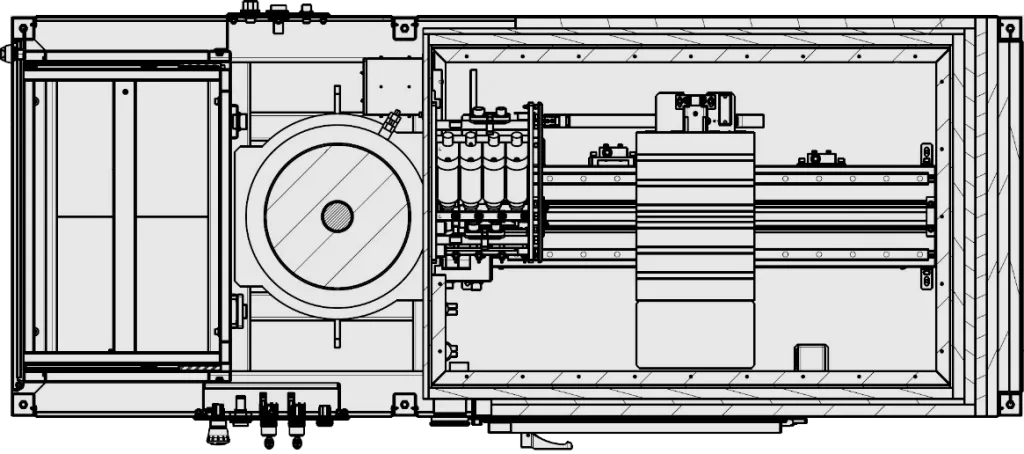
Overview
The irradiation chamber is shielded with lead of variousthicknesses.
The instruments to be calibrated are placed on the operating
table of the LPS. The operating table can be adjusted in heights
via the electric drives, as well as the instrument being calibrated
can be moved along the irradiation axis.
The set of attenuators consists of 4 lead attenuators and
ensures attenuation of the radiation flux from the source.
The control unit provides remote movement of sources in the
irradiator via the electric drives from the storage position to the
expose position and vice versa, positioning of the instruments
being calibrated along the X axis of the radiation beam, height
adjustment of the operating table and adjustment of attenuators.
Instruments to be calibrated are placed on the operating
table of the LPS through the door. All the mechanisms of the
installation are controlled via the central and adjustment
consoles in the adjustment and semi-automatic modes.
The video surveillance system consists of 3 video cameras
that provide control over the LPS platform position on a tape
measure, the readings of the instruments being calibrated
and the working chamber. The image from the cameras is
displayed on the PC of the operator.
The installation is equipped with 6 height-adjustable supports
and two specialized wheels used to move the assembled
installation over short distances (inside the room).
Characteristics
|
Air kerma
|
from 1.0 μGy/h to 14 Gy/h |
|
Exposure dose rate
|
from 114 μR/h to 1600 R/h |
|
Ambient dose equivalent rate (ADER)
|
from 1.2 μSv/h to 16.7 Sv/h |
|
Personal dose equivalent rate (PDER)
|
from 1.2 μSv/h to 16.9 Sv/h |
|
Confidence limits of relative errors of ambient dose equivalent rate, personal dose equivalent rate at confidence coefficient 0.95 if the system is certificated as
|
an operating standard of the second category - 7 % an operating standard of the third category - 10 % |
|
Confidence limits of relative errors of air kerma rate, exposure dose rate at confidence coefficient 0.95 if the system is certificated as
|
an operating standard of the second category - 5 % an operating standard of the third category - 8 % |
|
Relative error of detector positioning in radiation field (X axis), no more
|
± 0,15 % |
|
Quantity of sources
|
up to 2 |
|
Maximum 137Cs source activity, up to
|
2.4*1013 Bq (650 Ci) |
|
Maximum 137Cs sources total activity, up to
|
2.5*1013 Bq (680 Ci) |
|
Warm-up time
|
1 min |
|
Operation mode setup time, no more
|
1 min. |
|
Time of source transfer from storage/expose position to expose/storage position, no more, sec.
|
15 |
|
Diameter of uniform radiation field, at least
|
at a distance of 1 m from the gamma radiation source - 160 mm at field uniformity of no more than 6 % - 180 mm at field uniformity of no more than 9 % |
|
ADER at the surface if the source in storage position, no more
|
0.5 μSv/h |
|
ADER near the surface if the source in working position, no more
|
2 μSv/h at 30 cm from the surface |
|
Dimensions of the operating table
|
210x300 mm |
|
Dimensions of the irradiation chamber door aperture
|
460x460 mm |
|
Diameters of calimator outlet channel
|
90 mm |
|
Calimator channel length (from source center)
|
150 mm |
|
Range of the operating table movement along the Z-axis, at least
|
150 mm |
|
Operating distances range (along Х axis) from source center to instrument detector
|
from 300 to 1000 mm |
|
Movement speed of trolley (X axis)
|
from 0,5 mm/s to 0,1 m/s |
|
Dimensions
|
1860х880х1620 mm |
|
Weight
|
3500 kg |
|
Total weight of instruments installed on table, no more, kg
|
30 |
|
Time of system continuous operation, at least
|
24/7 |
|
Mean recovery time
|
no more than 6 h. |
|
Mean service lifetime
|
at least 15 years |
|
Mean time between failyres, no less than
|
60 000 h |
|
Atmospheric pressure
|
from 84 to 106,7 kPa |
|
Operating temperature
|
10 °C up to 35 °C |
|
Humidity
|
from 45 % to 80 % |
|
Supply voltage
|
230 V ± 10% |
|
Power consumption
|
no more than 600 V⋅A |
Advertising:
Advertising Leaflet
